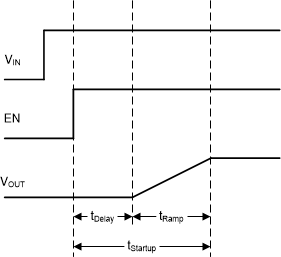SLVSEI1C June 2019 – October 2020 TPS62864 , TPS62866
PRODUCTION DATA
- 1 Features
- 2 Applications
- 3 Description
- 4 Revision History
- 5 Device Options
- 6 Pin Configuration and Functions
- 7 Specifications
- 8 Detailed Description
- 9 Application and Implementation
- 10Power Supply Recommendations
- 11Layout
- 12Device and Documentation Support
- 13Mechanical, Packaging, and Orderable Information
Package Options
Refer to the PDF data sheet for device specific package drawings
Mechanical Data (Package|Pins)
- YCG|15
Thermal pad, mechanical data (Package|Pins)
Orderable Information
8.3.3 Start-up
After enabling the device, there is an enable delay (tDelay) before the device starts switching. During this period, the device sets the internal reference voltage, and determines the start-up output voltage through the resistor connected to the VSET/VID or VSET/ PG pin. After tdelay, all registers can be read and written by the I2C interface.
 Figure 8-1 Start-up Sequence
Figure 8-1 Start-up SequenceAfter the enable delay, an internal soft start-up circuitry ramps up the output voltage with a period of 1 ms (tRamp). This avoids excessive inrush current and creates a smooth output voltage rising-slope. It also prevents excessive voltage drops of primary cells and rechargeable batteries with high internal impedance.
The device is able to start into a pre-biased output capacitor. It starts with the applied bias voltage and ramps the output voltage to its nominal value.